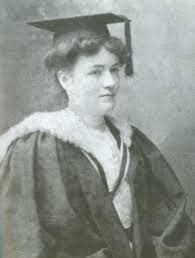Eibhlín Nic Niocaill facts for kids
Quick facts for kids
Eibhlín Nic Niocaill
|
|
|---|---|

Nic Niocaill at her graduation in 1906
|
|
| Born |
Eveleen Constance Nicolls
22 October 1884 Dublin, Ireland
|
| Died | 13 August 1909 (aged 24) Blasket Islands
|
Eibhlín Nic Niocaill (born Eveleen Constance Nicolls; 22 October 1884 – 13 August 1909) was a dedicated Irish activist. She was a key member of the Gaelic League, a group that worked to bring back the Irish language. Eibhlín was known for her intelligence, her love for Ireland, and her strong belief in women's rights. Sadly, her life was cut short at a young age.
Early Life and School Days
Eibhlín Nic Niocaill was born Eveleen Constance Nicolls in Dublin on 22 October 1884. She was the only daughter in her family, with four brothers. Her father, Archibald J. Nicolls, worked for the government.
Even though her father had a government job, her family had strong nationalistic beliefs. This meant they deeply loved Ireland and wanted it to be an independent country. They also spoke Irish at home. By 1901, Eibhlín was using the Irish spelling of her name. Her brother, George, later joined Sinn Féin, a political party that also wanted Ireland to be independent.
Eibhlín went to Loreto Convent schools in Rathmines and St Stephen's Green. She was an excellent student, especially good at languages. In her final exams, she won top prizes in Irish, French, and German. She then continued her studies at Loreto College, taking courses from the Royal University of Ireland.
She was always at the top of her class in college. She won many awards for her academic achievements. When she earned her first degree (a Bachelor of Arts, or BA) in 1906, she was the top student in all of Ireland! She also won a special scholarship called the Steward scholarship. To complete her master's degree (MA), she received a £300 travel scholarship. This allowed her to travel to Germany and Paris. There, she studied an older form of the Irish language called Old Irish. While in Paris, she even gave lectures at the University of Paris. She also helped reorganize the Parisian branch of the Gaelic League.
Working for Ireland and Her Tragic Death
When Eibhlín returned to Ireland, she became a very important member of the Gaelic League. She joined a local branch, gave lectures, and helped organize the 1909 Feis (a festival celebrating Irish culture). She wrote articles for the League's newspaper, An Claidheamh Soluis. In her writings, she connected the revival of the Irish language to Ireland's fight for independence. She also wrote about the importance of women's rights. Eibhlín was an early feminist, meaning she believed women should have equal rights and opportunities. She wrote for a magazine called Bean na hÉireann (Woman of Ireland). She had many friends, including famous Irish figures like Patrick Pearse and Mary E.L. Butler.
In the summer of 1909, she traveled with her friend Mary Butler to visit the Gaeltacht (Irish-speaking areas) in south Kerry. In previous summers, she had visited the Aran Islands. This helped her gain a deep understanding of the local Irish language spoken there. After a week in Dingle, Mary Butler went home. Eibhlín continued to Ventry to stay with Thady Kevane. There, she became friends with James Cousins. He described her as "tall, stately," and full of "sweetness and gentleness." Many people described her as modest, good-looking, and calm.
On 13 July 1909, Eibhlín arrived on the Great Blasket Island. She stayed in the house of Pádraig Ó Catháin, who was known as "the King" of the island. She loved the island so much that she decided to stay for a long time. While there, she started teaching the girls on the island how to swim.
On Friday, 13 August, Eibhlín was teaching Cáit, the daughter of Tomas O'Crohan, to swim. Even though they were only a few feet from the shore, Eibhlín and Cáit got into trouble in the water. Cáit's brother, Donal, tried to save them both. Another local man, Peats Tom Ó Cearnaigh, also came to help. He was able to save Cáit, but tragically, Eibhlín Nic Niocaill and Donal drowned.
Her death caused a huge wave of sadness across Ireland. She had just been elected to the Gaelic League's main committee, making her the youngest person ever to hold that position. A funeral service was held in Dunquin. Her body was then taken by train from Dingle to Dublin. Thousands of people met the train in Dublin and walked with her body to Glasnevin Cemetery for burial. Joseph Holloway, a famous diarist, wrote that it was the most solemn funeral he had ever seen. Patrick Pearse, a close friend, called Eibhlín the "most nobly planned" of all the women he knew.
The Gaelic League honored Eibhlín Nic Niocaill as a hero for trying to save Cáit. They sold pictures of her at their meetings. The money raised went to the O'Crohan family. By July 1910, 300 pictures had been sold, raising over £21. At a meeting on 9 September 1909, £49 was raised for a scholarship in her memory. This scholarship would help send a girl to the Gaeltacht. There were also plans for a statue or plaque dedicated to Eibhlín. In the next six months, £100 was raised, but these plans were never completed. Famous writers like Katharine Tynan, Padraic Colum, and James Cousins wrote tributes to her.
The book A Dark Day on the Blaskets by Mícheál Ó Dubhshláine was inspired by the sad events of Eibhlín Nic Niocaill's death. The play Snámh na Saoirse by Róisín Sheehy also tells the story of her drowning.

